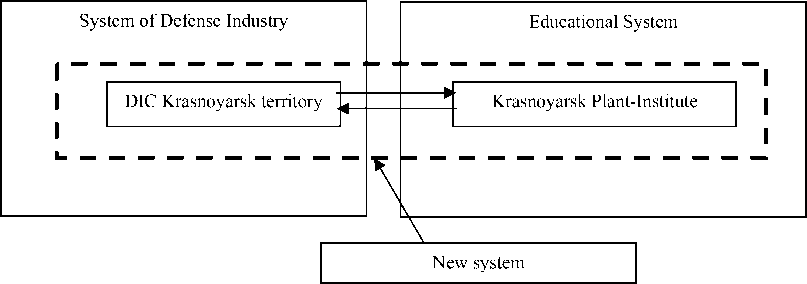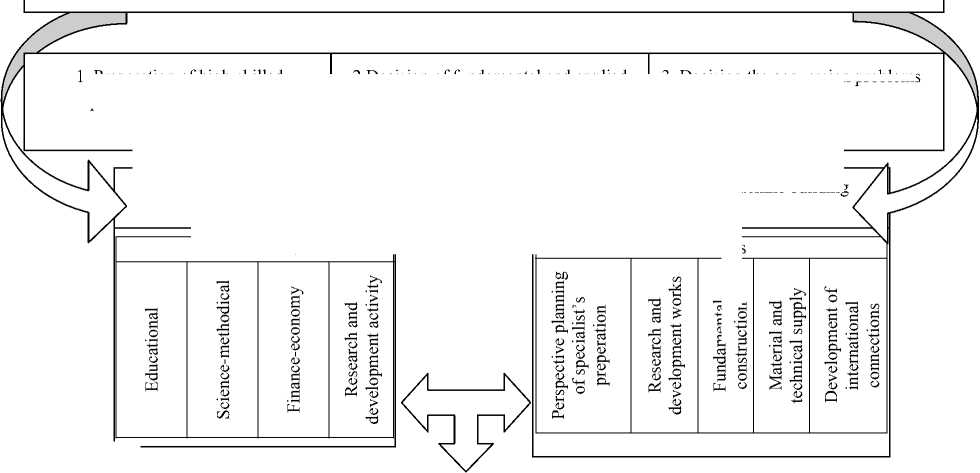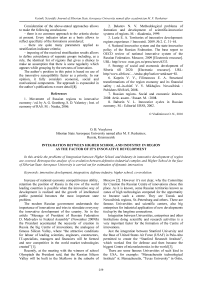Integration between higher school and industry in region as the factor of its innovative development
Автор: Voeykova O.B.
Журнал: Сибирский аэрокосмический журнал @vestnik-sibsau
Рубрика: Экономика
Статья в выпуске: 7 (33), 2010 года.
Бесплатный доступ
In this article the problems of Integration between Higher School and Industry in innovative development of region are covered. Retrospective analyze of co-evolution between defensive-industrial complex and Higher School in the face of Siberian State Aerospace University is carried out for estimation of dynamic interaction.
Innovative development, integration, defense industry, higher school, co-evolution
Короткий адрес: https://sciup.org/148176461
IDR: 148176461
Текст научной статьи Integration between higher school and industry in region as the factor of its innovative development
Increase of national economy competitiveness ability, retention the position of Russia in the row of the world leading countries is possible when the innovative way of development is realized and the growth of intellectual public potential becomes the most important state problem.
The modern Russian government understands the importance of innovations and tries to stimulate everyway the innovative development of the country. So in the article “Message of President of Russian Federation D. Medvedev to Federal Assembly” (November 2009th) the President accentuated the necessity of creation in Russia the big Centre of innovations, the analogous of famous Silicon Valley, where “the attractive conditions for labour of leading scientists, engineers, constructors, IT-specialists, managers and financiers will be formed and new competitive in the world market technologies created” [1].
Recently, at the meeting with the winners of school Olympiads the President said, that the Russian Silicon Valley will be built in the Skolkovo in the suburbs of
Moscow [2]. However it’s not clear, why the Committee for Creation the Russian Centre of innovations chose this place. As it is known, some Russian territories known as zones of high technologies competed for the opportunity to become such a centre. They are Tomsk and Novosibirsk regions, St.-Petersburg and others. There are famous Universities and scientific centers, also big enterprises for industrial application of new developments tied up by the longtime connections.
Just the integration between Stanford University and the Base of United States Air Force (USAF) in Palo-Alto permitted to create the “Stanford Research Institute”, which worked first for defense and then became the biggest Centre of microelectronics in the world [3].
There are some famous Universities of such kind in the USA, for example: “Massachusetts technological Institute” st. Massachusetts, “Texas University” in Ostin, st. Texas, University of Arisona and others, that demonstrate a wide range of different regions in innovative development of the country.
The innovative development orientation of regions is important especially for Russian territories, because they are characterized by extreme regional polarization, which is connected with essential disproportions in allocation of public-valued resources: fertile soils, climate conditions, natural resources , industrial enterprises and others. Innovative activity in Russian regions has to permit to eliminate the inequality of economic development of these territories.
Achievement the purposes of innovative development in a region demands realization of activities considering its competitive advantages. One of the most important competitive advantages in some regions of Russia is the defense industry which always has been a source of advanced scientific, technical, and technological achievements and developments. However, the powerful potential of defense industry is not employed totally under the conditions of activation the innovative development in regions.
Besides, some problems remain without attention, they are:
-
– estimation the scientific-innovative development influence of the of Higher School (HS) on the condition of research-and-production potential of enterprises in defense industry;
– stimulation of integration between HS and defensive-industrial complex (DIC) of region in innovative-technological direction.
All above-mentioned underlines the importance of researching the evolution of interaction between DIC and HS in region, and finding out the vector of their coevolution in conditions of region’s innovative development.
Krasnoyarsk territory is significant for such researches because it is characterized by the high concentration of defense industry enterprises, which have had tight connections with HS in the face of Siberian State Airspace University for a long time .
Formation of Siberian DIC began with the creation of two big enterprises for needs of space-rockets industry (SRI) in 50–60th. They were “Krasnoyarsk Machine- building plant” (“Krasmashzavod”) and construction bureau of M. F. Reshetnev in Zheleznogorsk. In 1960 on thу basis of the “Krasmashzavod” the special secret educational establishment was opened. Later “Research and Production Union of Applied mechanics” named after M. F. Reshetnev and other defensive enterprises of the region entered the number of basic enterprises. The unique educational system “Plant-Institute” was accepted in this Institute, which had to connect the student’s studies with the work at the enterprises of this branch [4].
Thus at the first stage of foundation the Siberian defense industry a certain system was formed, that involved the components of two bigger systems: defensive and educational one (fig. 1). Maintenance of this system integrity in the process of evolutional development depends on the degree of interaction stability of its components. The principle of co-evolution means mutual-adaptive variability of the system parts that leads to development acceleration of each of them and the system as a whole. According to this principle every mentioned component of the newly formed system ensured the development of another, and their interdependent development conduced to evolution of the whole system.
Such interpenetration between HS and defense industry resulted in the fact that each of this integrative system components was getting its advantages from fixed connections. The advantage for region defense enterprises from this interpenetration was foremost in permanent renovation of human resources, which had allowed to satisfy the needs of enterprises for modern specialists in concrete directions of engineer’s activity (production, designing, researching). High level of specialist’s university preparation for defensive-industry was most of all defined by unique educational programs, which were composed for development level of these enterprises, which were equipped enough with modern equipment conforming technological period.
The evolution of basic branch gave the unique opportunities for development of airspace Institute owing to presence of permanently acting integration in educational, research and production sphere. The Institute got especially intensive development in 80th under the exterior influence of DIC (fig. 2).

Fig. 1. Formation of the new production-educational system in region

The Strategy of branch’s integration

Idea:
Realization of root reorganization rockets-space industry and cosmic activity Tasks:

Е я с
S ■
The principle of double submission
1. Preparation of high-skilled specialists in sphere of SRI
2 Decision of fundamental and applied tasks in creating the rockets-space technique
3. Decision the conversion problems in SRI
Ministry of higher and secondary education
Ministry of common machine building
Functions
Functions
The branch’s Institute
Results:
improvement of material base of the Institute increaseе of the level of specialist’s education consolidation of science-pedagogical potential
Fig. 2. The Institute as an object of co-management by two branches of economy (the principle of double submission)
Just then the Institute was transferred in double submission by attaching to two departments – the Ministry of higher and secondary education of RSFSR and the Ministry of common machine building of RSFSR, each with certain number of functions. This was the precedent for whole system of higher education in the country and showed the efficiency of strategy of branch’s integration for the development of educational establishment, owing to that the multichannel financing of Institute became possible
The change in economic and political conditions in the country in 90th, connected with disintegration of Soviet Union, realization of new liberal market reforms, liquidation of the Ministry of common mashing building in RSFSR put both DIC and HS in a very complicated situation that resulted in considerable deformations of integrative co-evolution connections.
The integrity of Institute-enterprises system DIC was broken. Stagnation of one of the components hampered another. DIC was not interested in keeping up the connections with profile Institute, because it was on the verge of survival itself.
However, in spite of all difficulties of crisis period, the Institute showed its flexibility, mobility, and readiness to transformations developing even faster then the basic branch, whose enterprises were necessary to re-profile the production on the lower technical level.
Searching new ways of basic branch development according to the interests of civil economic sector, transition to market relations gave the impulse to enlargement the spectrum of educational directions among which besides conventional – rocket-space appeared such as: the exploitation of air transport, IT and computers, economics and management, humanitarian sphere. In period since 1990 per 2009 the list of specialties opened in the Institute enlarged essentially.
Economic specialties got intensive development connected with fast increase of the need in economic specialists and managers during the transition to market relations.
The necessity in enlargement of science-educational activity, attracting additional investment determined the Institute entering the international level. Nowadays the Institute is the member of European Convocation Business Education (ECBE) and International Company Engineers Pedagogic (ICIP). Stable connections were contacted with Czech technical University in Prague, High technical School and University of state New York in Oneonta (SUNY), the Rocket-Space Centre and International cosmic camp in Huntsville (USA). The Institute collaborates effectively with different foreign partners, such as Universities of Germany, Holland, Finland and Great Brittan.
Actually there is big necessity in engineers, who have got profound economic knowledge, also the knowledge in sphere of international relations, can perform the system analysis of the native and foreign high-tech space markets, and who have high level of speaking foreign languages.
So the High International School of Business in structure of the Airspace University is becoming especially actual in conditions of almost total absence of specialists of such level on the native enterprises in space industry.
On this stage of development the Siberian State Airspace University is characterized by high degree of innovative potential, so it has:
– innovative structure of organization, that includes the educational, production and scientific components;
– high share of innovative specialties (more than 50 %), which are oriented upon the modern requirements of high-tech innovative sector of economy;
– innovative technologies, which are realized in the University;
– a great number of high skilled stuff, professors and tutors, among them there are many representatives from industrial enterprises, branches and academic research and development institutions;
– considerable experience of realization fundamental and applied researches, experimental developments according to science-technical programs at different levels: International, Federal, Industrial, Regional and so on, so the University has got high potential in partial realization of linear model of innovations;
– innovative infrastructure as the combination of interconnected and complementary subdivisions consolidated in functional blocs, which ensure the realization of scientific-research and applied works combined with education;
– the University is a member of Association “National United Airspace University”, that is the innovative structure of Higher Airspace Education in Russian Federation and includes 9 Russian Airspace Universities.
Taking into account the fact that the space industry entering the market has to be based on modern conceptual basis, science-methodical support and the highly-qualified stuff that is adapted to the new conditions, it is necessary to emphasize the progressive urgency of consolidation the integrative connections between DIC and Higher Airspace School. At the same time Airspace Universities bares the role of initiator and equal partner of this integration, that permits to inculcate their educational, scientific-research experience and accumulated innovative potential in development of DIC. So the raise of the industry makes the positive dynamic effect on development of airspace higher education as a whole.


